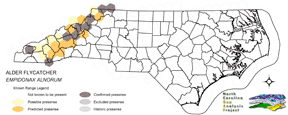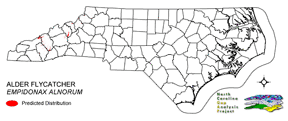
| Taxa: |
| Order: |
| Family: |
| Aves |
| Passeriformes |
| Tyrannidae |
| NatureServe Global Rank: |
| NatureServe State (NC) Rank: |
| G5 |
| S2B,SZN |
| Federal Status: |
| NC State Status: |
| --- |
| SR |


| Land Unit |
| US Fish & Wildlife Service |
| US Forest Service |
| US National Park Service |
| US Department of Defense |
| NC State Parks |
| NC University System |
| NC Wildlife Res. Com. |
| NC Forest Service |
| NC Div. of Coastal Mgmt. |
| Local Governments |
| Non-Governmental Org. |
| Other Public Lands |
| Private Lands |
| GAP Status 1-2 |
| All Protected Lands |
| Statewide |
| Hectares |
| 0.00 |
| 9,735.48 |
| 0.00 |
| 9,742.95 |
| 593.73 |
| 0.54 |
| 68.85 |
| 0.00 |
| 0.00 |
| 588.06 |
| 1,305.27 |
| 0.00 |
| 8,407.08 |
| 13,509.72 |
| 22,032.09 |
| 30,441.96 |
| Acres |
| 0.00 |
| 24,056.89 |
| 0.00 |
| 24,075.35 |
| 1,467.14 |
| 1.33 |
| 170.13 |
| 0.00 |
| 0.00 |
| 1,453.13 |
| 3,225.39 |
| 0.00 |
| 20,774.34 |
| 33,383.24 |
| 54,442.47 |
| 75,223.71 |
| % of Dist. on |
| Prot. Lands |
| 0.0 % |
| 44.2 % |
| 0.0 % |
| 44.2 % |
| 2.7 % |
| < 0.1 % |
| 0.3 % |
| 0.0 % |
| 0.0 % |
| 5.9 % |
| 5.9 % |
| 0.0 % |
| 0.0 % |
| 61.3 % |
| ----- |
| ----- |
| % of Dist. on |
| All Lands |
| 0.0 % |
| 32.0 % |
| 0.0 % |
| 32.0 % |
| 2.0 % |
| < 0.1 % |
| 0.2 % |
| 0.0 % |
| 0.0 % |
| 1.9 % |
| 4.3 % |
| 0.0 % |
| 27.6 % |
| 44.4 % |
| ----- |
| ----- |
|
Rare and local in the northwest mountains (Hamel 1992) with occurrences listed in Watauga and Haywood counties, as well as near Roan Mtn. and in the Black mountains (Hamel 1992, Lowther 1999, Potter et al 1980, Simpson 1992). In the higher elevations, both bogs with scattered shrubs and saplings, and uplands with shrub/saplings thickets, are used (Hamel 1992). Kaufman (1996) lists this flycatcher as normally occurring 'near water, as around streams, ponds, or bogs.' Nest is usually in a deciduous shrub or sapling (Hamel 1992, Lowther 1999), averaging about 2 feet above the ground (Kaufman 1996). Construction consists of grass, weeds, strips of bark, small twigs, rootlets, and lined with plant down according to Kaufman (1996). The Alder Flycatcher hunts exclusively from perches with tall shrubs or low trees, either hawking them from the air or gleaning from the foliage (Kaufman 1996, Lowther 1999). NATURE SERVE GLOBAL HABITAT COMMENTS: Brushy and scrubby growth, thickets, deciduous forest edge, open second growth, and swamps. NON-BREEDING: also woodland, but migrants seldom enter tall shady second growth or woodland (Stiles and Skutch 1989). Nests in damp thickets of alder and various shrubs, in bogs, along marshy borders of lakes, and in brush along stream banks, less than 2 m above ground (Harrison 1979). |
| Code | Name | Description | NC Natural Heritage Program Equivalent |
| 228 | Piedmont Dry-Mesic Oak and Hardwood Forests | Primarily oak dominated forests, white oak is often dominant, with co-dominants including . Also represented by sweetgum and tulip poplar dominated forests. | Dry Mesic Oak Hickory Forest, Basic Oak Hickory Forest, Dry Oak Hickory Forest |
| 36 | Successional Deciduous Forests | Regenerating deciduous trees with a shrub stature. Commonly dominated by sweetgum, tulip poplars and maples. | No equivalent |
| 521 | Spruce/Fir Forest | High Elevation Frazer-Fir - Red Spruce, Red Spruce and Red-Spruce-Yellow Birch Forests. Tree densities included here include both woodland to forest density. Highly intermixed with Northern Hardwoods, Grassy Balds, and Shrub Balds. | Red Spruce--Fraser Fir Forest, Fraser Fir Forest |
| 524 | Shrub Bald | Variable phenologies, predominantly evergreen balds with rhododendon and Mountain laurels. Deciduous shrubs including green alder and Alleghany and smooth blackberry are included as well. Red Oak - Chestnut Oak Woodlands may be included in cases where the density of the woodland species is low and the shrub component is dense. | Heath Bald |
| 533 | Appalachian Swamp Forest | Evergreen and deciduous forests with saturated hydrologies. This class may contain a variety of trees species, including hemlock - red maple, pitch pine, and white pine forests. | Swamp Forest-Bog Complex, Southern Appalachian Bog, Southern Appalachian Fen |
| 534 | Appalachian Wet Shrubland/ Herbaceous | Saturated shrubs and herbaceous vegetation. Often mapped as an inclusion in Appalachian Swamp Forest. | Southern Appalachian Bog, Southern Appalachian Fen |
|
Winkler, K. 1994. Divergence in the mitochondrial DNA of EMPIDONAX TRAILLII and E. ALNORUM, with notes on hybridization. Auk 111:710-713.
Bent, A.C. 1942. Life histories of North American flycatchers, larks, swallows, and their allies. U.S. National Museum Bulletin 179. Washington, DC. Hamel, P. B. 1992. The land manager's guide to the birds of the south. The Nature Conservancy, Chapel Hill, North Carolina. 367 pp + several appendices. Simpson MB Jr. 1992. Birds of the Blue Ridge Mountains. Chapel Hill and London: University of North Carolina Press. Kaufman K. 1996. Lives of North American Birds. Boston, New York: Houghton Mifflin Company. Lowther, P. E. 1999. Alder flycatcher. In Poole A. and Gill F., eds. The birds of North America. No. 446. Harrison, C. 1978. A field guide to the nests, eggs and nestlings of North American birds. Collins, Cleveland, Ohio. Harrison, H.H. 1979. A field guide to western birds' nests. Houghton Mifflin Company, Boston. 279 pp. Keast, A., and E. S. Morton. 1980. Migrant birds in the Neotropics; ecology, distribution, and conservation. Smithsonian Inst. Press, Washington, D.C. Potter, E. F., J. F. Parnell, and R. P. Teulings. 1980. Birds of the Carolinas. Univ. North Carolina Press, Chapel Hill. 408 pp. Terres, J.K. 1980. The Audubon Society encyclopedia of North American birds. Alfred A. Knopf, New York. American Ornithologists' Union (AOU), Committee on Classification and Nomenclature. 1983. Check-list of North American Birds. Sixth Edition. American Ornithologists' Union, Allen Press, Inc., Lawrence, Kansas. Stiles, F.G., and A.F. Skutch. 1989. A guide to the birds of Costa Rica. Comstock Publ. Associates, Cornell University Press, Ithaca, New York. 511 pp. Droege, S., and J.R. Sauer. 1990. North American Breeding Bird Survey, annual summary, 1989. U.S. Fish and Wildlife Service, Biological Report 90(8). 22 pp. |
For more information please contact them at:
NC-GAP Analysis Project
Dept. of Zoology, NCSU
Campus Box 7617
Raleigh, NC 27695-7617
(919) 513-2853
www.basic.ncsu.edu/ncgap